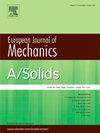通过延时反馈抑制具有三比一内部共振的悬索的振动
IF 4.4
2区 工程技术
Q1 MECHANICS
引用次数: 0
摘要
基于延时反馈控制,研究了具有三比一内部共振的悬索的振动抑制问题。首先,考虑了延时反馈控制下悬索的非线性运动微分方程,并利用 Galerkin 方法推导出离散模型。随后,采用多尺度法对离散时延微分方程进行扰动求解,确定了第一个主谐振周围的调制方程。数值检测了调制方程的稳态解和周期解。数值结果表明,内部共振增强了受控悬索的非线性动力学复杂性。据观察,时间延迟和控制增益会影响受控系统:特别是,控制增益的增加会导致响应振幅的减小。通过调整时间延迟和控制增益,可以改变临界激励,这在实际应用中非常有用。这项研究揭示了悬挂缆索错综复杂的动力学特性,为在工程应用中设计更有效的控制策略奠定了理论基础。本文章由计算机程序翻译,如有差异,请以英文原文为准。
Vibration suppression of suspended cables with three-to-one internal resonances via time-delay feedback
Based on the time-delay feedback control, the vibration suppression of suspended cables with three-to-one internal resonances are investigated. Initially, the nonlinear differential equation of motion for a suspended cable under time-delay feedback control is considered, and a discrete model is derived using the Galerkin method. Subsequently, the method of multiple scales is employed to perturbatively solve the discrete time-delay differential equation, determining the modulation equations around the first primary resonance. Steady-state and periodic solutions of the modulation equations are detected numerically. Numerical results indicate that the internal resonance enhances the nonlinear dynamical complexity of the controlled suspended cable. It is observed that the time delay and control gain affect the controlled system: in particular, an increase in control gain leads to a reduction in response amplitude. By adjusting the time delay and control gain, the critical excitation can be altered, an aspect that could be very useful from a practical point of view. This research sheds light on the intricate dynamics of suspended cable and provides a theoretical foundation for designing more effective control strategies in engineering applications.
求助全文
通过发布文献求助,成功后即可免费获取论文全文。
去求助
来源期刊
CiteScore
7.00
自引率
7.30%
发文量
275
审稿时长
48 days
期刊介绍:
The European Journal of Mechanics endash; A/Solids continues to publish articles in English in all areas of Solid Mechanics from the physical and mathematical basis to materials engineering, technological applications and methods of modern computational mechanics, both pure and applied research.

 求助内容:
求助内容: 应助结果提醒方式:
应助结果提醒方式:


